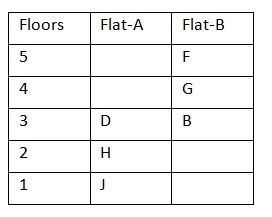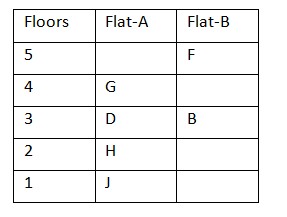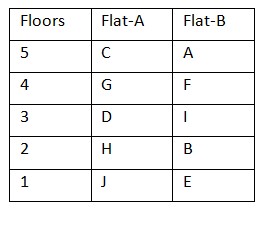Question
__ and __ live on same
floor. Answer the questions based on the information given below: Ten persons (A, B, C, D, E, F, G, H, I and J) live on 10 different flats of a 5 storey building, where the bottommost floor is 1 and the floor above is 2 and so on. There are 2 types of flats on each floor, flat A and flat B such that flat A is in the west of flat B. Flat A of floor 1 is immediately below of flat A of floor 2, which is immediately below of flat A of floor 3 and so on, similarly for flat B. The dimensions of each of the flats is same There are two floors between the floors of J and G (both of them may or may not live in the same type of flat). J lives on first floor. J lives south west of B. F lives 2 floors above B (both live in the same type of flat). D lives immediately above floor H, who doesn’t live anywhere below B’s floor. A lives above D’s floor but not in flat A. E doesn’t live on a prime numbered floor. C doesn’t live immediately above B.Solution
There are two floors between the floors of J and G (both of them may or may not live in the same type of flat). J lives south west of B. J lives on first floor. F lives 2 floors above B (both live in the same type of flat). D lives immediately above H, who doesn’t live below anywhere B’s floor. So, G must live above J’s floor either in flat A or B. Both F and B live in flat B. Case 1: When G lives in the flat B.  Case 2(a): When both G and J live in the same flat and J lives on 1st floor. H doesn’t live below B’s floor, so this case is not possible.
Case 2(a): When both G and J live in the same flat and J lives on 1st floor. H doesn’t live below B’s floor, so this case is not possible.  A lives above D’s floor but not in flat A. E doesn’t live in a prime numbered floor. C doesn’t live immediately above B. So, A lives in on 5th floor in flat B. Case 2(b): When both G and J live in the same flat and J live on 1st floor. The final arrangement is as follows:
A lives above D’s floor but not in flat A. E doesn’t live in a prime numbered floor. C doesn’t live immediately above B. So, A lives in on 5th floor in flat B. Case 2(b): When both G and J live in the same flat and J live on 1st floor. The final arrangement is as follows: 
Choose the correct option from below mentioned change in voice of the given sentence:
The nurse is looking after this little girl.
Addressing the participants since inaugurating (A)/the conclave, the minister said (B)/water and sanitation is a significant sector (C).
The patient waited in dread for the trolley it would taken him to the operation theatre.
And those predicting total economic mayhem may still be forced to eat humble pie by this time next year if economic growth starts to pick...
Choose the correct combination of grammatically incorrect sentences
I. The growing trend towards sustainable and responsible investing is prom...
Identify the highlighted part of speech, choose the correct answer
The man disappeared with the cash.
Which of the phrases given below the sentence should replace the phrase in bold to make the sentence grammatically correct.
An example sentence w...
Non-autonomous expenditure (A) has to go up sufficiently to create (B) a growth momentum that allays workers’ fears that they might (C) not have a job...
The Union Environment Ministry, make (A) with safeguarding India’s forests and its environmental assets, threatening (B) to amend s...
Find the part containing error. If none of the four parts contains error, mark ‘No Error’ as your answer.
Laptops, tablets, and personal co...
Relevant for Exams:


